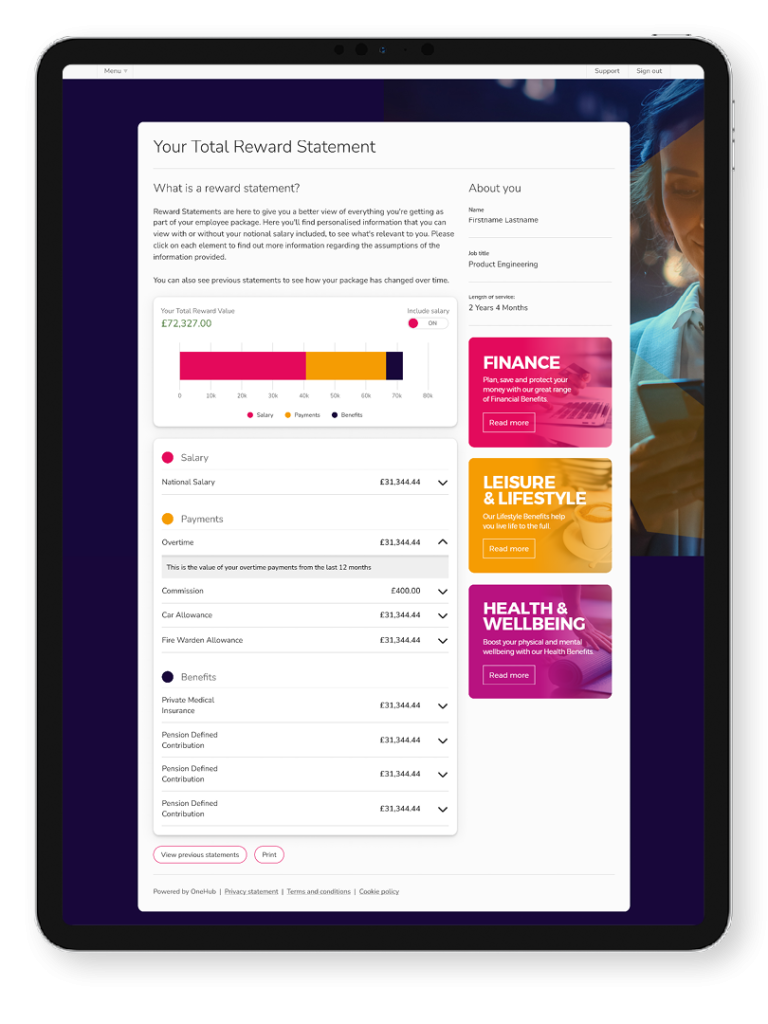
Employee Benefits
A brief guide to total reward statements
21-03-2023
Eight in ten employees underestimate the value of their total reward by up to 30%.
As this statistic shows, there’s a gap between what employers are doing for their employees and employee perceptions of the rewards and support they receive. This perception gap can damage the way employees think about their employer and can impact employee engagement, retention and acquisition.
It’s all very well telling employees that you’re doing a lot to support them, but showing the value you’re contributing to each individual is much more powerful.
Enter the total reward statement (TRS). A TRS can help you bridge the perception gap – it’s a fantastic way to show employees exactly how much you’re investing in them. And a TRS had another key advantage: it can help you increase benefits engagement, so a TRS is an important part of your overall employee experience.
What to include in a total reward statement
We’re seeing an increasing number of global organisations choosing to provide their employees with total reward statements as part of their employee benefits programmes. A part of the employee benefits platform, a TRS is a summary of everything employees receive from their employer and is completely personalised to the individual. A TRS often includes:
- Income from salary
- Bonus and overtime payments
- Any funding and allowances they have e.g. fuel allowance or wellbeing account
- An overview of their benefits, including pension. It will show how much their organisation is paying towards each benefit
- It can also include non-financial and voluntary benefits
Some organisations provide a physical printout of a TRS but most provide a digital version as part of their benefits platform – so it’s in real time. Here’s an example total reward statement on the Benefex’s OneHub | Benefits platform:

An important part of your EVP
A new generation is entering the workforce, bringing a very different set of expectations and values beyond a competitive salary. To be competitive in the market you operate in, you need to be able to attract and retain the best talent. We have seen employees become ‘consumers of the workplace’. So, as well as offering competitive salaries and benefits, employers need to look at the micro interactions your employees have with your business, purposefully designed or not. To meet employee’s evolving expectations, employers need to provide elements of work that didn’t exist just 10 or 15 years ago:
- Income from salary
- Bonus and overtime payments
- Any funding and allowances they have e.g. fuel allowance or wellbeing account
- An overview of their benefits, including pension. It will show how much their organisation is paying towards each benefit
- It can also include non-financial and voluntary benefits
In terms of what an employer can deliver, these elements can be grouped under the interlinking umbrellas of employee experience and personalisation – and can all be displayed within total rewards.
As well as providing transparency as employees can instantly see the full value of their reward, a TRS helps you to demonstrate your commitment to your employees, both now and in the future. As a result, you can use it as a fantastic selling tool at recruitment stage to allow your HR team to showcase your EVP at a glance. An intelligent TRS will go one step further and help you to segment the messaging within to highlight benefits which employees of a similar age or role have found appealing.
Total rewards as part of the communications toolkit
Sixty-four percent of all employers who have invested in benefits fail to tell their employees about them at all. That would be like Apple launching a brand-new product but not advertising it. Key to any organisation’s cultural success is communicating your offering well – otherwise there’s not much point in having them at all!
Globally, employers are losing £22.75bn through employee turnover and absence because they fail to communicate their reward & benefit offerings effectively. There are a whole host of on- and offline options you can utilise to make sure you personalise your communications and reach everyone in a way that will resonate. Take a look at our new guide to global benefits communications if you’d like to learn more about how to drive benefits engagement with messaging that cuts through the noise of employees’ inboxes.
But it’s also worth remembering that a TRS is itself an effective communications tool. If you’ve signposted employees to where to find their statement, the nature of TRS is self-explanatory, easy to follow, and all-inclusive. In OneHub, the total reward statements overview can be found right next to our benefits selection menu meaning that employees logging in to view it can also easily explore at the benefits on offer to them.
Ultimately, providing a total reward statement for employees will pay dividends in employee engagement, increased benefits take-up, and employee advocacy across the business. Those employers who invest in showcasing their offering through a clear, concise, real-time and easy-to-use total reward statements find their retention is improved, their recruitment package is more attractive to top talent, and their culture is one of transparency and safety.
If you have any questions or want to get a demo of our benefits platform, fill out our form and one of our team will be in touch.



